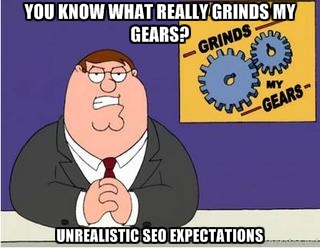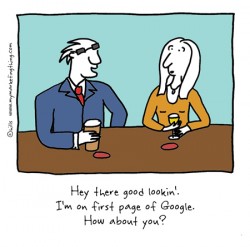SEO Basics
Annoyingly Basic SEO…

Previously we had a quick look at the great black hole that is Google’s set of SEO ranking algorithms that place your site somewhere on the SERPs and probably not where you’d like to be.
So…let’s look a some basic steps can you implement to make some quick progress on getting placed somewhere useful on these SERPs……..
Currently the most commonly accepted basic SEO factors are listed below, but remember no matter what yo do CONTENT is always KING:
Targeted Keywords
Very important to have your SEO targeted keywords in your website title HTML tags. Google uses these tags to work out the subject matter of your pages. Accepted studies have shown that pages that contain their target keyword in the title tag generally perform better on SERPs than pages without this in place.
Backlinks
Try to focus on building good quality inbound and outbound links. Although the quality of links is very important, the more the merrier as the total number of in-bound and out-bound links pointing to your site is also an important ranking consideration for Google.
Social Connections
Try to get people to share the content of your site on as many social media platforms as you can. Google is starting to pay more attention to social links on sites. This fairly recent increasing SEO consideration is indicative of the increasing emphasis Google is placing on the sharing/caring…/people networking nature of the web.
So let us take a look at some of these fundamental points and given that these are often overlooked, getting these correct in themselves will likely to get you a long way better SERPs ranks, in theory, well we did mention previously this is a black hole and a constantly moving one at that…
Oh almost forgot……, before you even look at these you better make sure your site runs under the HTTPS protocol and not the unsecured HTTP, this is going to affect rankings a lot in the near future and it can be quite troublesome making this change depending on the size of your site!
How Implement These Annoyingly Basic SEO Considerations On Your Site
Title Tags
This is possibly most important HTML tag that you need get right with when it comes to improving your rankings.
For any search engine to rank your web site, it has to know what your site content is about, what each of the pages is about and definitely what your site as a whole is about; relevance and popularity…
Title Tags are shown on Google results thus:

Meta Description Tags
Immediately after your title tags is the meta tag and it’s correct use is an absolute must if you are serious about SEO. The meta description consists of additional few lines of text that add detail to what the content of your site is really all about.
As well as assisting in ranking well on SERPs, if properly worded it will also encourage the “clicking” through to your website from search results.
Your Meta Description Tags are shown on Google results thus:

Header Tags
HTML Header tags are very easy to include in your content and they are part of the actual page text.
There are a few HTML header tags and depending on your page structure and content you may be employing H1, H2,H3, H4, H5 and H6 tags. These HTML header tags produce progressively decreasing text sizes and are generally used as indicators of headings and subheadings in organizing your page content.
These header tags are simply indicated in HTML as follows:
<h1> C-NEST Cloud and Server Experts </h1>
good use of header and sub-header HTML tags lets Google know how to structure your page results when they are presented on the SERPs.
Image Alt Tags
Clearly search engines cannot read pictures/images, they read the website text! However, it’s possible to win more SEO points by ensuring that your images are all provided with Image Alt Tags.
It’s advisable to include a description of what the image is showing and it’s not necessary that this Image Alt Tag is actually relevant to the page on which your image sits.
Images are able to do their own separate SEO thing if you so desire by making use of the Image Alt Tags you are giving your website images an opportunity to be ranked and listed on the Google results images tab!
CMS’s such as WordPress make it simple to add Image Alt Tags to your pictures by providing an Alt Text box as part of the stored content image meta-data.
NoFollow Link Tags
NoFollow links implemented with the “relative” attribute on links is an important consideration. These were an attempt to reduce the massive volume and weight given to “spammy” links being posted all over the internet like crazy, by bots in the hope that the “more the merrier” consideration in the SERPs ranking algorithms would dissapear. NoFollow links are the type of links generated in forums and blogs, so in theory, given they are ignored in link counting ranking importance, the ‘bot’s can now stop their “spammy” link postings.
Seems that the volume of “spammy” link posting has not reduced as expected but these posted links are now not considered as genuine links for ranking purposes.
These are really about helping you with credibility or domain authority, “dofollow” linking to a domain/site with a low level of credibility or domain authority will negatively impact on your own SERPs ranking. Similarly getting backlinks to your own site that are classifed as “dofollow” will add to your own domain authority and SERPs rankings.
There is still a lot of ambiguity around the value and treatment of “nofollow” links by the Google SERPs algorithms, safest strategy is to make sure that you are linking to external resources using the rel attribute set to “NoFollow”, that way you will at least not be penalized by linking to low authority domains!
Simple to make use of these, just use the “rel” attribute within the link tags:
Again the web is littered with “NoFollow” links papers, thinking and guesses but here’s the little that Google has to say on the matter:
Link and Anchor Text Tags
In the spooky land of page ranks sculpting, Link and Anchor Test Tags are definitely not up there in the nebulous nether-lands of “how to waste your time on infinitesimally small and probably meaningless SEO tweaks”; if back-links matter to SERPs then so does Anchor Text. These are basic on-page text elements that assist Google algorithms in analyzing your site structure and linking, they are easy to get right and they matter.
These are easy to get right and to get an easy positive impact on your SERPs.
Here is a link with good anchor text:
<a href=”http://www.c-nest.com/hosting”>Web Hosting Information</a>
and a link with not so good anchor text:
<a href=”http://www.c-nest.com/hosting”>More</a>
A good and brief overview on Anchor Texts can be found here but once again the web is littered with Anchor Text thoughts and muses, happy searching.
Canonical Tags
Sounds a little esoteric, but simply means following a standard or precedent (at least in techie speak). These are simple to implement “rel” attributes that remove the confusion for SEO algorithms around duplicate content on your site, and duplicate content can come with SERPs penalties!
Since we are talking about how these are considered by the omnipresent Google search engine algorithms, this is what they have to say on the matter and will clearly explain why most websites are likely to contain ‘duplicate content’:
This is how simple it is to indicate the Canonical versions of your website content:
<link rel=”canonical” href=”http://www.c-nest.com/http/?page_id=13531″ />
In Conclusion
We don’t want to re-invent the wheel here, we offer and implement basic advice and strategies for the websites that we host, the point we are making is that you do need to consider SEO and at least get the basics right!
There are literally millions of articles on SEO for you to research and take advantage of, I recommend sites such as the following, if you really want to start digging deeper into SEO:
I suggest that for most of us 100’s of tips are not “quick” to implement and if your that deep into the Google SERPs algorithms you’re likely to find a new purpose in your life to keep you awake 24/7… constantly second guessing the mysteries of the ever moving Google SERPs algorithms!
Finally and to you rescue! Almost all modern CMS’s such as WordPress allow the setup of these basic SEO considerations either directly via their dashboards or via plug-ins and one of the best for WordPress is the free and incredibly useful Yoast SEO plug-in, even better, if you’re hosting your site with C-NEST Botswana Web Hosting Services, we’ll take care of all of this for you!
raymond
2018-03-11T14:15:47+00:00
We'd really appreciate you sharing our posts wherever you can!











